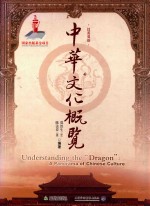

中华文化概览 中英版PDF电子书下载
- 电子书积分:12 积分如何计算积分?
- 作 者:郑铁生(中),陈发春(英)编著
- 出 版 社:天津:天津教育出版社
- 出版年份:2010
- ISBN:9787530961629
- 页数:319 页
第一章 龙的故乡 1
一、龙的文化 1
二、传说中的祖先——黄帝 2
三、中国最早的文字——甲骨文 3
四、《易经》 4
五、司马迁和《史记》 5
第二章 孔子和儒家 7
一、孔子与《论语》 7
二、孔子与儒家学派 8
三、曲阜与“三孔” 9
第三章 老子与道教 11
一、老子 11
二、道教 12
三、道教的养生术 14
四、道教的洞天福地 15
第四章 佛教在中国 17
一、玄奘取经 17
二、四大石窟 18
三、四大佛教名山 22
四、藏传佛教和喇嘛寺庙 25
第五章 古代教育 27
一、官学与私学 27
二、书院文化 29
三、科举制 32
四、《百家姓》《千字文》《三字经》 33
第六章 古代科技 35
一、四大发明 35
二、祖冲之和圆周率 38
三、郭守敬修订历法 38
四、李冰和都江堰 39
五、世界上最长、最古老的大运河 41
第七章 古代建筑 42
一、园林建筑 42
二、宫殿建筑 45
三、陵墓建筑 46
四、万里长城 48
五、古都的建筑 49
第八章 古代工艺 53
一、青铜器 53
二、兵马俑 54
三、唐三彩 56
四、瓷都景德镇和五大古窑 57
五、四大名砚 59
六、中国的雕刻 60
七、玉器文化 64
八、四大名绣 65
九、“泥人张”与惠山泥人 67
十、扎染 68
第九章 古代文学 70
一、《诗经》和“楚辞” 70
二、唐诗 71
三、宋词 74
四、明清小说 76
第十章 国画、书法、篆刻 78
一、中国画 78
二、人物画 79
三、山水画 84
四、花鸟画 85
五、中国书法 87
六、中国篆刻 89
第十一章 中国民间艺术 91
一、乐器 91
二、民歌 92
三、民族舞 94
四、秧歌 96
五、舞狮 97
第十二章 中国戏曲 99
一、京剧艺术 99
二、京剧四大名旦 101
三、京剧脸谱艺术 103
四、京剧服饰 104
五、秦腔、皮影 105
第十三章 曲艺、杂技 108
一、相声 108
二、快板和快板书 109
三、鼓曲 110
四、评书 112
五、吴桥杂技 113
第十四章 中医文化 114
一、阴阳五行与医学 114
二、《黄帝内经》 115
三、神医华佗 116
四、张仲景与《伤寒论》 116
五、李时珍与《本草纲目》 117
六、望闻问切 118
七、针灸铜人 119
第十五章 货币文化 121
一、贝币、布币、刀币、方孔铜钱、铜圆 121
二、金币、银币 122
三、纸币 123
四、纪念币 124
第十六章 饮食文化 126
一、宫廷御膳 126
二、四大菜系 127
三、面点小吃 130
四、传统筵席 132
五、酒文化 132
六、品茗之道 134
第十七章 中华武术 135
一、拳术 135
二、武术与养生 137
三、武术与兵法 138
四、十八般兵器 140
五、十八般武艺 141
第十八章 古代中外文化交流 143
一、东渡日本的鉴真和尚 143
二、丝绸之路 145
三、马可·波罗到中国 146
四、郑和下西洋 147
编后语 149
Understanding the “Dragon”: A Panorama of Chinese Culture 151
Preface 153
Foreword 155
Chapter One The Origin of the Dragon 157
Dragon Culture 157
Emperor Huangdi—the Legendary Chinese Ancestor 158
The Oracle Bone Inscription—the Earliest Chinese Writing Script 160
I Ching—The Book of Changes 161
Sima Qian and Shiji 162
Chapter Two Confucius and Confucianism 164
Confucius and The Analects of Confucius 164
Confucius and Confucianism 165
Qufu and Confucian Mansion, Temple and Cemetery 166
Chapter Three Laozi and Taoism 169
Laozi 169
Taoism 170
Taoism Regimen 173
Cave Heaven and Blessed Region 174
Chapter Four Buddhism in China 176
Xuan Zang’s Pilgrim to India 176
Four Reputed Grottoes 177
Four Sacred Mountains of Buddhism 182
Tibetan Buddhism and Lama Temples 185
Chapter Five Ancient Education 188
Public and Private Schools 188
The Classical Academy 190
The Imperial Civil Examination System 191
Hundred Family Surnames, Thousand-character Classic and Three-character Scripture 193
Chapter Six Ancient Technologies 195
The Four Great Inventions 195
Zu Chongzhi and His π 199
Guo Shoujing and His Improved Calendar 200
Li Bing and His Dujiang Weir 201
The Grand Canal—the Longest and the Oldest in the World 203
Chapter Seven Ancient Architecture 205
Garden Architecture 205
Palatial Architecture—The Imperial Palace 207
Tombs and Mausoleums 209
The Great Wall 211
Architecture of Ancient Capitals 212
Chapter Eight Ancient Arts and Crafts 218
Bronze Artifacts 218
Terracotta Army 219
Tang Sancai Glazed Pottery 221
Jingdezhen—the China Capital and Home of the Four Ancient Kilns 222
Four Famous Varieties of Ink Stones 223
The Art of Chinese Sculpture and Carvings 224
Jade Culture 227
Four Brand-name Embroidery Styles 229
Clay Figurine Zhang and Clay Figurine Huishan 230
Bandhnu 232
Chapter Nine Ancient Literature 233
The Book of Songs and “Songs of Chu” 233
Tang Poetry 234
Song Poetry 236
Novels of the Ming and Qing Dynasties 238
Chapter Ten Chinese Painting, Calligraphy and Seal Cutting 240
Chinese Painting 240
Figure Painting 242
Landscape Painting 245
Bird-and-flower Painting 247
Chinese Calligraphy 248
Chinese Seal Cutting 250
Chapter Eleven Chinese Folk Art 252
Chinese Musical Instrument 252
Folk Songs 254
Folk Dance 255
Yangko 258
Lion Dance 259
Chapter Twelve Chinese Opera 261
The Art of Beijing Opera 261
Four Famous Dans of Beijing Opera 262
The Art of Facial Makeup in Beijing Opera 265
Beijing Opera Costumes 266
Shaanxi Opera and the Shadow Play 267
Chapter Thirteen Quyi and Acrobatics 270
Xiangsheng 270
Kuaiban and Kuaibanshu 271
Guqu 272
Pingshu 274
Wuqiao Acrobatics 275
Chapter Fourteen Chinese Medicine 277
Yin-yang and Wu-hsing in Chinese Medical Theory 277
Huangdi Neijing 278
Hua Tuo—the Divine Doctor 279
Zhang Zhongjing and Shanghanlun 280
Li Shizhen and Bencaogangmu 280
The Four Diagnostic Methods 281
The Bronze Acupuncture Figure 282
Chapter Fifteen The Culture of Money 284
Shell Money, Spade Money, Knife Money, Square-holed Copper Money and Copper Coins 284
Gold and Silver Coins 286
Paper Money 287
Commemorative Coin 288
Chapter Sixteen Cuisine 290
Gong Ting Yu Shan 290
Four Major Chinese Cuisines 292
Flour-made Food and Snacks 295
Traditional Yan Xi 297
Chinese Wine Culture 298
Chinese Tea Culture 299
Chapter Seventeen Wushu—Chinese Martial Arts 301
Chinese Boxing 301
Wushu for Health Preservation 302
Wushu and the Art of War 304
The 18 Types of Weapons 305
The 18 Types of Feat 306
Chapter Eighteen Cultural Exchanges with the World 307
Jianzhen and His Voyages to Japan 307
The Silk Road 309
Marco Polo and His Travels to China 311
Zheng He and His Voyages to the Occident 312
Afterword 315
附录 318
中国历代纪元表A Brief Chronology of Chinese History 318
- 《东北民歌文化研究及艺术探析》(中国)杨清波 2019
- 《了不起的中华文明 你好,四大发明!》蒙曼,张迪 2019
- 《大学英语教学的跨文化交际视角研究与创新发展》许丽云,刘枫,尚利明著 2020
- 《卓有成效的管理者 中英文双语版》(美)彼得·德鲁克许是祥译;那国毅审校 2019
- 《跨文化交际背景下的中西文化比较研究》任永进,贺志涛著 2019
- 《生态文化建设的社会机制研究》阮晓莺著 2019
- 《党内政治文化建设指南》苏玉主编 2017
- 《白纻舞及其歌辞的文化解读》王俊,曹化根著 2019
- 《中华国学经典精粹 春秋左氏传》左丘明,常亚光 2017
- 《人间词话 中华经典藏书》王国维著;张浴兮译注 2015
- 《市政工程基础》杨岚编著 2009
- 《家畜百宝 猪、牛、羊、鸡的综合利用》山西省商业厅组织技术处编著 1959
- 《《道德经》200句》崇贤书院编著 2018
- 《高级英语阅读与听说教程》刘秀梅编著 2019
- 《计算机网络与通信基础》谢雨飞,田启川编著 2019
- 《看图自学吉他弹唱教程》陈飞编著 2019
- 《法语词汇认知联想记忆法》刘莲编著 2020
- 《培智学校义务教育实验教科书教师教学用书 生活适应 二年级 上》人民教育出版社,课程教材研究所,特殊教育课程教材研究中心编著 2019
- 《国家社科基金项目申报规范 技巧与案例 第3版 2020》文传浩,夏宇编著 2019
- 《流体力学》张扬军,彭杰,诸葛伟林编著 2019
- 《培智学校义务教育实验教科书教师教学用书 生活适应 二年级 上》人民教育出版社,课程教材研究所,特殊教育课程教材研究中心编著 2019
- 《习近平总书记教育重要论述讲义》本书编写组 2020
- 《办好人民满意的教育 全国教育满意度调查报告》(中国)中国教育科学研究院 2019
- 《教育学考研应试宝典》徐影主编 2019
- 《语文教育教学实践探索》陈德收 2018
- 《家庭音乐素养教育》刘畅 2018
- 《学前教育学》王换成主编 2019
- 《近代体育游戏教育史料汇编 第1辑 1》王强主编 2016
- 《全国学前教育专业(新课程标准)“十三五”规划教材 简谱手风琴教程 第2版》(中国)杨克勤,王宝庆 2019
- 《现代教育技术》李志河主编 2019
